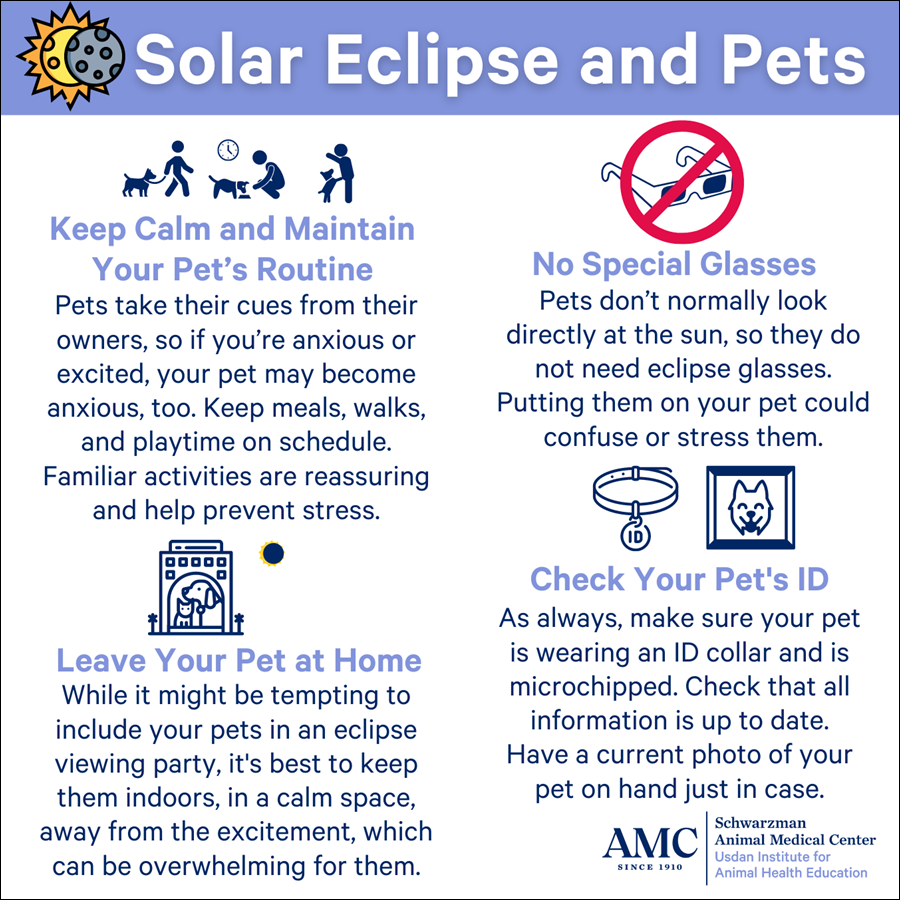Understanding animal reactions to a solar eclipse
A look at the behavior of zoo and companion species and how veterinary professionals and their clients can keep pets safe and calm during this rare meteorological event
Photo: Kolonko/Adobe Stock

A solar eclipse is a rare event that may lead to anomalous behaviors in many species of animals.1 However, veterinary experts say there are precautionary measures that can be taken to keep companion animals safe and free of stress during the eclipse forecasted for Monday, April 8, 2024, in some US states.2,3
Studies based on previous solar eclipses provide insight into potential animal behaviors that may occur during the next event. In one recent study, investigators observed the behaviors of 17 species at the Riverbanks Zoo in Columbia, South Carolina, during a solar eclipse on August 21, 2017, and compared these observations to baseline behaviors shown prior to the meteorological event. The 2020 study’s results found that 75% of these mammals, birds and reptiles were observed exhibiting a behavioral response to the eclipse.1
Unusual behaviors
Notably, the study found a majority of those responses were animals engaging in behaviors that mimicked their evening or nighttime routines. These included Western lowland gorillas, African elephants, giraffes, and Komodo dragons approaching their respective enclosures, and increased movement or activity shown by avian species such as tawny frogmouth, Major Mitchell’s cockatoo, and masked lapwing.1
Investigators concluded that the change in light, and possibly temperature, during the solar eclipse were cues that determined animal behaviors.1 Likewise, veterinarians at Texas A&M University School of Veterinary Medicine and Biological Sciences in College Station, noted in a news release unusual pet behavior during a solar eclipse may be attributed to a disruption of their internal clocks because, like humans, many animals are accustomed to being active during the day and resting at night.2
Apparent anxiety was the second-most common behavioral response to the solar eclipse that was demonstrated in the study at Riverbanks Zoo. Investigators observed Hamadryas baboons and giraffes engaging in coordinated running as well as pacing. Other demonstrations of apparent anxiety included group consolidation around juveniles, and increased vocalization by American flamingoes and rainbow and coconut lorikeets. Investigators found these behaviors associated with apparent anxiety in alignment with previously published observations of wild animals during an eclipse and thus suggested a casual link between anxiety and the meteorological event.2
Pet safety and comfort
Image courtesy of Usdan Institute for Animal Health Education of the Schwarzman Animal Medical Center

Ahead of the next solar eclipse, professionals at the Usdan Institute for Animal Health Education of the Schwarzman Animal Medical Center, a level 1 veterinary trauma center in New York, New York, and Texas A&M clinical professors Kristina Paradowski, DVM, and Isabelle Louge, DVM, provided insights about limiting stress for companion animals and keeping them safe. Their tips, which can be shared with clients, include the following2,3:
- Stay calm: Animals are sensitive to human emotions and actions, so remaining composed is important, according to the Usdan Institute.
- Keep pets indoors: Crowds, noise and commotion could be stressors for animals, and increased traffic pose a higher risk for accidents and trauma. For these reasons, Paradowski recommended not taking pets to eclipse viewing events.
- Maintain a calm environment: Keep lights on and play soothing music to help facilitate a comforting atmosphere. Additionally, a favorite snack can be given to a pet motivated by food, while physical touch such as petting may help others.
- Maintain routines: Adhering to regular schedules facilitates senses of normalcy and comfort, which help to mitigate stress or anxiety while an unfamiliar event is occurring.
- Check identification: Ensure pets are microchipped and wearing collars with ID tags. Should they become fearful and run off, this precaution may prove invaluable, according to the Usdan Institute.
Large animal care
For large animals, Louge noted that cattle, horses and other herd animals should be kept in a familiar environment that is free of hazards such as ravines or potholes. Their environment should be easy to navigate for them as eclipse dims the natural light to help avoid injuries.2
Louge also noted that large animal owners should keep a safe distance during the eclipse since the herd’s behaviors may become erratic. She recommended owners avoid working with these animals during the meteorological event and not exposing them to loud noises or flashes of light.2
Takeaway
Lastly, the experts at the institute and Texas A&M do not recommend pets or other animals wear glasses or other eyewear specifically designed to shield them from the eclipse. According to these experts, animals instinctively avoid staring at the sun and there is a lack of research to support pet eye safety measures in the event of a solar eclipse.2,3
References
- Hartstone-Rose A, Dickinson E, Paciulli LM, et al. Total eclipse of the zoo: animal behavior during a total solar eclipse. Animals. 2020;10(4):587. doi:10.3390/ani10040587
- Texas A&M University School of Veterinary Medicine and Biological Sciences. Pets and the solar eclipse. Texas A&M University. April 5, 2024. Accessed April 5, 2024. https://today.tamu.edu/2024/04/05/pets-and-the-solar-eclipse/
- Tips to keep pets safe during the solar eclipse from Schwarzman Animal Medical Center. News release. Schwarzman Animal Medical Center. April 5, 2024.
Podcast CE: A Surgeon’s Perspective on Current Trends for the Management of Osteoarthritis, Part 1
May 17th 2024David L. Dycus, DVM, MS, CCRP, DACVS joins Adam Christman, DVM, MBA, to discuss a proactive approach to the diagnosis of osteoarthritis and the best tools for general practice.
Listen